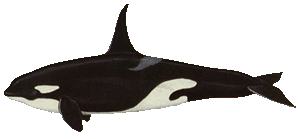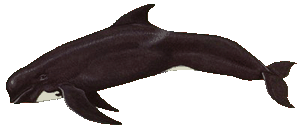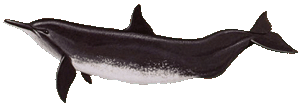|
|
|
|
|
Back to the main menu of species Killer Whale 
Scientific Name: Orcinus orca Other Names: Grampus, Great Killer Whale Length: 18-32.3 ft. (5.5-9.8 m.) Weight: 2.6-9 tons Teeth: 40-52 Killer whales are the largest member of the dolphin family. These animals work together herding and harassing their intended prey until it tires, then they make their kill. Their prey includes sharks, seals, penguins, fish, and whales. Their activities include lobtailing, breaching, flipper-slapping, spy-hopping, beach-rubbing, speed-swimming, and dogging, however, they rarely bow ride or wake ride. There are two distinct forms of Killer Whales, transients and
residents. Transients tend to form small pods, feed on mammals, vocalize less
frequently, and stay underwater longer. Resident pods are larger, have smaller
home ranges, feed on fish, and usually keep to predictable routes.
Longfin Whale 
Scientific Name: Globicephala melas Other Names: Pothead Whale, Atlantic Pilot Whale, Longfin Whale Length: 12.5-9.8 ft. (3.8-6 m.) Weight: 1.8-3.5 tons Teeth: 30-50 Pilot Whales have a white patch under
the chin. This patch narrows to a slim white line along the stomach. The flippers
on pilot whales are long and pointed. Long-finned pilot whales have longer flippers,
more teeth, and slightly different skulls than short-finned pilot whales. Long-finned
pilot whales generally take several quick breaths, then submerge for several
minutes. Entire pods are sometimes seen logging, allowing boats to approach closely.
Long-Snouted Spinner Dolphin 
Scientific Name: Stenella longirostris Other Names: Longsnout, Rollover, Spinner Length: 4.3-7 ft. (1.3-2.1 m.) Weight: 100-165 lbs. (45-75 kg.) Teeth: 170-252 The spinner dolphin has a long graceful beak and
a small overall appearance. Many spinner dolphins associate with schools of yellowfin
tuna, which has led to their being killed by the hundreds of thousands by purse-seine
tuna-fishing operations during the past twenty years. Unlike many other species of
cetaceans, obvious differences exist in physical characteristics of males and females.
Males possess a bump on the ventral peduncle and a forward cant on the dorsal fin.
Melon-Headed Whale 
Scientific Name: Peponocephala electra Other Names: Many-toothed Blackfish, Electra Dolphin Length: 7-9 ft. (2.1-2.7 m.) Weight: approx. 355 lbs. (160 kg.) Teeth: 84-100 At a great distance, melon-headed whales are
difficult to distinguish from pygmy killer whales. Pygmy killer whales possess a larger
white patch on their undersides than the melon-headed whales. They are know to
jump completely out of the water while they swim and bow ride. In captivity they
seem to incite fear reactions in other dolphins (in some cases), however, this species
may associate with fraser's dolphins and cetaceans such as the spinner dolphins.
This species is also know to strand in large numbers.
Please dont forget to sign my guestbook as I love getting mail.Sign my Dreambook! |